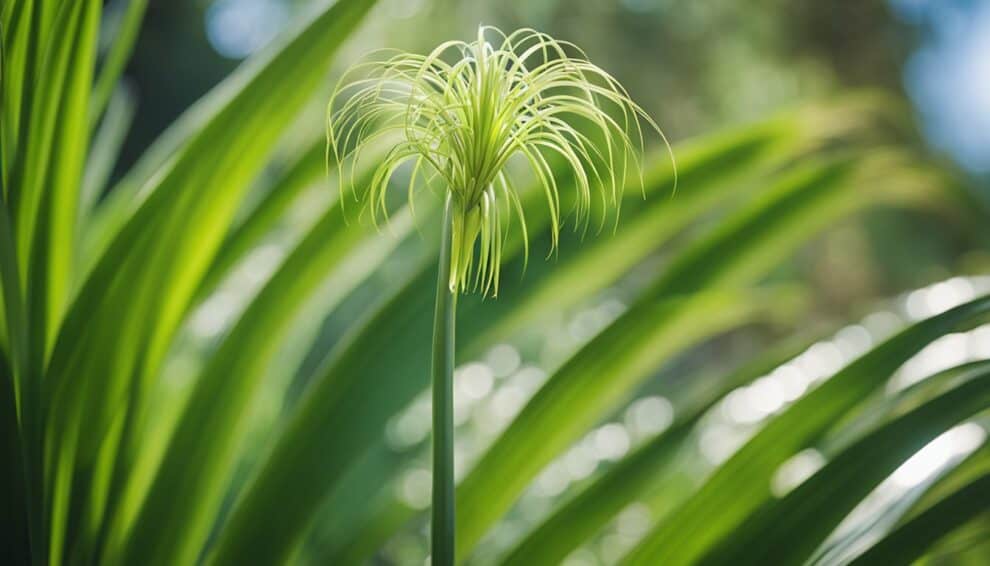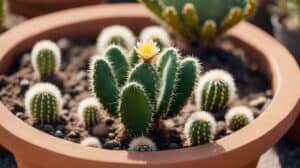The Ponytail Palm (Beaucarnea recurvata) is a unique and striking plant that is known for its thick trunk and long, curly leaves. Also known as the Elephant’s Foot Palm, this plant is native to Mexico and Central America and is a popular choice for indoor and outdoor gardening. One of the most exciting aspects of the Ponytail Palm is its ability to be propagated, allowing plant enthusiasts to create new plants from the parent plant.

Propagating a Ponytail Palm can be a fun and rewarding experience, and it’s surprisingly easy to do. There are several methods of propagation, including seed propagation and vegetative propagation, which involves using offsets or pups from the parent plant. In this guide, we will explore the different methods of propagation and provide step-by-step instructions on how to successfully propagate your own Ponytail Palm. Whether you’re a seasoned gardener or a beginner, this guide will provide you with the knowledge and confidence to grow your own beautiful Ponytail Palms.
Understanding Ponytail Palm Biology
Characteristics of Beaucarnea Recurvata
Ponytail Palm (Beaucarnea recurvata) is a popular houseplant due to its unique appearance and low maintenance requirements. It is native to Mexico and belongs to the Asparagaceae family. The plant is also known as the Elephant’s Foot Tree due to its swollen base, which stores water.
The leaves of the Ponytail Palm are long and thin, resembling a ponytail, hence the name. The plant can grow up to 30 feet tall but typically stays smaller when grown as a houseplant. The leaves can grow up to 6 feet long and are dark green in color.
Ponytail Palm is a slow-growing plant and can take years to reach its full height. It is also a long-lived plant and can live for up to 100 years.
Growth Patterns and Lifecycle
Ponytail Palm is a monocotyledonous plant, which means it only has one embryonic leaf. The plant produces flowers on a long stalk that emerges from the center of the plant. The flowers are small and white or yellow in color and are followed by small fruit.
The plant reproduces through seeds, which can take up to six months to germinate. However, Ponytail Palm can also be propagated through offsets, which are small plants that grow from the base of the parent plant.
Ponytail Palm is a drought-tolerant plant and can survive long periods without water. However, it does require well-draining soil and should not be overwatered. The plant prefers bright, indirect light but can also tolerate low light conditions.
Overall, understanding the biology of Ponytail Palm is important for successful propagation and care of this unique and fascinating plant.
Preparation for Propagation

Optimal Season for Propagation
Ponytail Palm propagation is best done in spring or summer when the plant is actively growing. This is when the plant is most likely to produce new shoots and roots, making it easier to propagate. Avoid propagating during winter when the plant is dormant, as it may not survive.
Tools and Materials Needed
To propagate a Ponytail Palm, you will need the following tools and materials:
- Pruning shears
- Sharp knife
- Rooting hormone
- Potting soil
- Small pots or containers
- Clear plastic bag or plastic wrap
Make sure your tools are clean and sharp to avoid damaging the plant.
Selecting a Healthy Parent Plant
Choose a healthy Ponytail Palm as the parent plant for propagation. Look for a plant with a sturdy stem, healthy leaves, and no signs of disease or pests. A mature plant is best for propagation, as it will have a better chance of producing new shoots and roots.
Before propagating, make sure the parent plant is well-watered. This will make it easier to remove the offsets without damaging the roots.
Propagation Techniques

There are three main methods for propagating ponytail palm: seed propagation, offset division, and cutting propagation. Each method has its own advantages and disadvantages, so it is important to choose the one that best suits your needs.
Seed Propagation Method
The seed propagation method is the most time-consuming and challenging method of propagating ponytail palm. However, it is also the most rewarding, as it allows you to grow new plants from scratch. To propagate ponytail palm from seeds, follow these steps:
- Soak the seeds in warm water for 24 hours.
- Fill a container with well-draining soil and plant the seeds about 1 inch deep.
- Keep the soil moist and warm, and place the container in a bright, indirect light location.
- Germination can take up to 3 months, so be patient.
Offset Division Method
The offset division method is the easiest and most common method of propagating ponytail palm. This method involves separating the offsets, or small plants that grow at the base of the parent plant, and planting them in their own containers. To propagate ponytail palm using the offset division method, follow these steps:
- Carefully remove the parent plant from its container.
- Gently separate the offsets from the parent plant, taking care not to damage the roots.
- Plant the offsets in their own containers filled with well-draining soil.
- Water the new plants and place them in a bright, indirect light location.
Cutting Propagation Method
The cutting propagation method is the most challenging method of propagating ponytail palm, as it requires a bit of skill and patience. This method involves taking a cutting from the parent plant and rooting it in soil. To propagate ponytail palm using the cutting propagation method, follow these steps:
- Choose a healthy stem from the parent plant and cut it at an angle.
- Allow the cutting to dry for a few days.
- Plant the cutting in a container filled with well-draining soil.
- Water the cutting and place it in a bright, indirect light location.
- It can take several months for the cutting to root and start growing, so be patient.
Remember to keep the soil moist and the new plants in a bright, indirect light location. With proper care, your new ponytail palm plants will thrive and bring a touch of whimsy to your home or garden.
Post-Propagation Care

After successfully propagating a ponytail palm, it’s important to provide proper care to ensure its health and growth. This section covers the key aspects of post-propagation care, including watering and feeding, ideal lighting and temperature, and potting and repotting tips.
Watering and Feeding
Ponytail palms are drought-tolerant and prefer to be slightly underwatered rather than overwatered. After propagation, it’s important to let the soil dry out between waterings to avoid root rot. The frequency of watering depends on the size of the plant and the environment it’s in. In general, it’s recommended to water once every 1-2 weeks.
When it comes to feeding, ponytail palms don’t require frequent fertilization. During the growing season (spring and summer), you can use a balanced fertilizer once every 2-3 months. Avoid fertilizing during the dormant season (fall and winter).
Ideal Lighting and Temperature
Ponytail palms prefer bright, indirect light but can also tolerate low light conditions. After propagation, it’s important to gradually introduce the plant to brighter light to avoid sunburn. Keep the plant away from direct sunlight, which can cause leaf scorch.
In terms of temperature, ponytail palms prefer warm temperatures between 60-80°F (15-27°C). They can tolerate cooler temperatures down to 50°F (10°C) but should be protected from frost.
Potting and Repotting Tips
After propagation, it’s recommended to keep the plant in its original container until it outgrows it. When it’s time to repot, choose a container that’s slightly larger than the current one and has drainage holes. Use a well-draining soil mix and avoid overpotting, as ponytail palms prefer to be slightly root-bound.
When repotting, be careful not to damage the plant’s delicate roots. Gently loosen the soil around the roots and remove any dead or damaged roots. Water the plant thoroughly after repotting and avoid fertilizing for a few weeks to allow the roots to settle.
Frequently Asked Questions

How can I propagate a Ponytail Palm from a cutting?
Propagation of Ponytail Palm from cuttings can be tricky, but it is possible. The best time to propagate is in the spring or summer when the plant is actively growing. Use a sharp, sterile knife to cut a healthy stem from the plant, making sure it has at least one node. Allow the cutting to dry out for a few days before planting it in well-draining soil. Keep the soil moist and warm, and the cutting should root within a few weeks.
What is the best method to root a Ponytail Palm branch?
The best method to root a Ponytail Palm branch is by air layering. This involves making a small incision in the bark of the branch and wrapping it with moist sphagnum moss. Cover the moss with plastic wrap and secure it with string or tape. Keep the moss moist and roots should form within a few months. Once the roots have formed, cut the branch below the moss and plant it in well-draining soil.
What are the steps to remove and propagate Ponytail Palm pups?
Ponytail Palm pups can be removed from the parent plant by gently pulling them away from the base of the plant. Once removed, allow the pup to dry out for a few days before planting it in well-draining soil. Keep the soil moist and warm, and the pup should root within a few weeks.
Can Ponytail Palm be propagated in water, and if so, for how long?
Ponytail Palm can be propagated in water, but it is not the best method. Cuttings can be placed in water, but they may not root as easily as they would in soil. If you choose to propagate in water, change the water every few days and keep the cutting in a warm, bright location. Roots should form within a few weeks.
What should I do if the top of my Ponytail Palm breaks off?
If the top of your Ponytail Palm breaks off, don’t worry. The plant will often continue to grow from the remaining stem. If the stem is healthy, it should produce new growth within a few weeks. If the stem is damaged or rotting, it may be best to remove the entire plant.
How do Ponytail Palm side shoots develop into multiple heads?
Ponytail Palm side shoots develop into multiple heads through a process called branching. As the plant grows, it will produce new shoots from the base of the plant. Over time, these shoots will grow into separate heads, giving the plant a more bushy appearance. To encourage branching, make sure the plant is in a bright location and is receiving enough water and nutrients.













